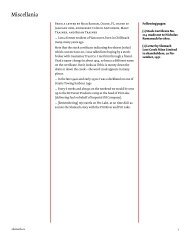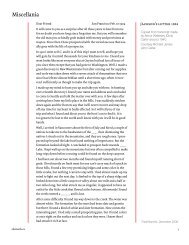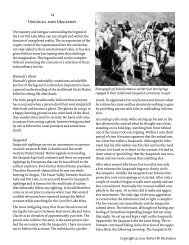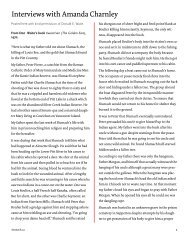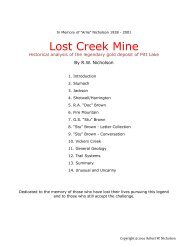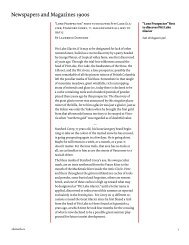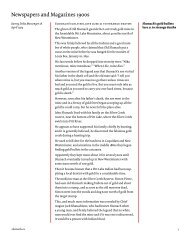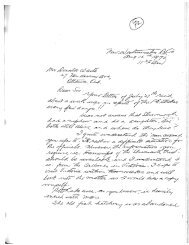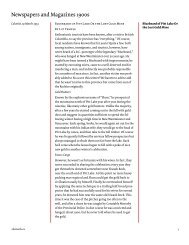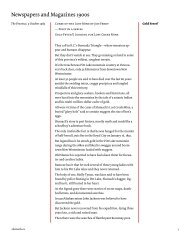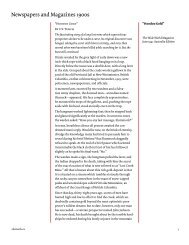Newspapers and Magazines 1900s - Slumach
Newspapers and Magazines 1900s - Slumach
Newspapers and Magazines 1900s - Slumach
You also want an ePaper? Increase the reach of your titles
YUMPU automatically turns print PDFs into web optimized ePapers that Google loves.
<strong>Newspapers</strong> <strong>and</strong> <strong>Magazines</strong> <strong>1900s</strong>(Reprinted as “Volcanic Brown” in Boundary Historical SocietyReport No. 8, 1979)Old miner knew the end was nearDeath didn’t hurry day of decisionBy Cecil ClarkIt was about 3 o’clock on a November afternoon <strong>and</strong> it wassnowing.It had been snowing for days in that mile-high wildernessthat marks the timberline source of Stave River, near wild <strong>and</strong>lonely Homestead Glacier, high on the south slopes of GaribaldiPark.Beside a stunted, snow-covered spruce tree is an almostequally snow-laden pup tent. In it, in a dilapidated patchedsleeping bag lies a tall, emaciated old man. The man shelteringfrom the blizzard is called Brown; the year is 1931.Once, long ago, he was dubbed “Crazy” Brown. Later it became“Volcanic” Brown, <strong>and</strong> later still someone called him “Sunset”Brown. You could take your choice. The only sign of grubaround his makeshift camp is a small piece of smoke-blackenedbear meat, wired to the branch of the spruce tree outside.Beside him in the tent is a small cooking pot, a h<strong>and</strong> axe <strong>and</strong>a single barrelled shotgun, for which there are no shells. Daysbefore the last vestiges of his meagre supply of flour, tea <strong>and</strong>tobacco had gone. Now his strength is going, <strong>and</strong> he knows it.Even if it quits snowing, which is doubtful, the gruelling tripback across the glacier to the hatchery at Alvin on Pitt River isbeyond him.For one thing he has no grub, no shells <strong>and</strong> no matches. Foranother he’s minus the toes of his left foot, <strong>and</strong> for another…he is 82 years old.Maybe in these final hours, as he watches vagrant snowflakestwirling in occasionally through the tent opening, old “Volcanic”Brown has thoughts of other years, of other occasionswhen he matched his wits with Fate, <strong>and</strong> somehow managedto make out. This time, however, it’s too late. Trapped in themountains without food or fire, there’s only one decision hecan make. He can wait in his sleeping bag until drowsed bysoft <strong>and</strong> languorous sleep from which he’ll never awake. Or hecan get on his feet <strong>and</strong> for the last time fight the wilderness inone hopeless but defiant gesture.+++Old miner knew the endwas near: Death didn’thurry day of decisionDaily Colonist 21 June 1959Courtesy Michael Collierslumach.ca1
<strong>Newspapers</strong> <strong>and</strong> <strong>Magazines</strong> <strong>1900s</strong>The old man who lay in the freezing solitude that Novemberafternoon used to sign his name “A.R. Brown.” But few everknew what the “A.R.” stood for. If you mentioned “Volcanic”Brown, especially among miners <strong>and</strong> prospectors, everyoneknew him.You would have known him as a 10-year-old boy if you hadlived in the village of St. Martin’s, New Brunswick, 100 yearsago. He was the seventh son in a family of 17 born to Dave <strong>and</strong>Nancy Brown (of good old Nova Scotia Royalist stock) whofarmed in sight of the wind-swept Fundy. His ship-owninggr<strong>and</strong>father had chosen the King’s side in Boston, backin 1776, an act of allegiance that cost him seven merchantships <strong>and</strong> property along the Charles River, valued today at$200,000.000.At 10 young Brown was working on his father’s farm, <strong>and</strong> at15 was out trapping with an Indian b<strong>and</strong>. Later he fished fromtops’l schooners out of Fundy <strong>and</strong> later still helped build theIntercontinental Railway at Mafapedia. For a time he trappedin the Shickshock Mountains, then rafted logs on Quebec’sriver Lorette.He must have been a vociferous young fellow in his 20s fullof new fangled ideas about capital <strong>and</strong> labor. Maybe that’swhy at 32 he formed a union in the Michigan woods <strong>and</strong> led15,000 loggers out on a two-week’s strike for a pay increase.In after life he often was heard to mention that banks shouldbe abolished <strong>and</strong> the government should take their place.Somewhere along the line he turned his back on religion,<strong>and</strong> used to remark that all churches should be turned intoschoolrooms. Once he even figured out a cure for tuberculosisby “equalizing the electrical impulses of the body” )whatever that meant ), <strong>and</strong> 50 years ago he shrewdly opinedthat one day all the forests would be gone <strong>and</strong> aluminiumwould be the building material of the future.It was while the CPR was being built through the Rockies thathe first struck B.C., <strong>and</strong> after prospecting in the mountainsmade himself a dugout canoe <strong>and</strong> drifted down the Columbianto Colville, Washington. This was the occasion whenconstruction workers called him “Crazy” Brown. Crazy ornot, he came back into B.C. to climb forbidding peaks, checking<strong>and</strong> sampling ore specimens, until finally he located theVolcanic Mine near Gr<strong>and</strong> Forks in the late ‘80s.“A mountain of pure copper,” he told gaping byst<strong>and</strong>ersat the Forks, then outlined leviathan plans for a series oftunnels clear into the mountains to bring out the fabulousquantities of ore.2 slumach.ca
<strong>Newspapers</strong> <strong>and</strong> <strong>Magazines</strong> <strong>1900s</strong>“We’re going to need half a dozen railroads in here to carryit out,” he said enthusiastically. “And we’ll need plenty ofsmelters.”He even laid out a townsite of Volcanic City ten miles northof Gr<strong>and</strong> Forks, <strong>and</strong> included in the tract plenty of roomfor smelters. He got capital too, $20,000,000, they say, butfinally came disagreements <strong>and</strong> litigation which cost him$63,000 in legal fees. He got the money trapping—trapping ahundred square miles of country.Finally came complete disillusionment when the VolcanicMine failed to live up to its promise.He was no sooner down than he was up, for in 1888 he discoveredthe Sunset Mine on Copper Mountain near close toPrinceton, which developed into one of the biggest copperproperties in the province. It, too, needed capital, so Volcanicsold his interest for $45.000 <strong>and</strong> celebrated the deal by gettinghimself a set of solid gold false teeth!It took close to $4,000,000 to develop the Sunset Mine, butunder the wing of Granby Consolidated it was a terrific producerfor nearly 40 years.+++The light was waning in the November sky as the old manthinks of his mining ventures, of money made <strong>and</strong> lost.Maybe he thinks too up here in the snowbound solitudeof Stave Glacier, of the decision he is soon to make; whichreminds him in turn of other decisions in his long, adventurouscareer. Perhaps he’s reminded of one he had to make inGr<strong>and</strong> Forks seven years before.It all started when Bill Brown, a shock headed tie cutter <strong>and</strong>saw mill worker went on one of his periodical razin’, tearin’drunks. Bill was a fairly reasonable individual when he wassober, but a living terror when liquored up. He’d only been acouple of years in the Similkameen, <strong>and</strong> the year before hadmarried a widow with three children.It was on May 9, 1921, that Bill cut loose. Most of the morninghe’d been drinking around Gr<strong>and</strong> Forks, then around noon(armed with a couple of bottles) he got in his rig <strong>and</strong> headedback to his cabin at Volcanic City.On the way home, somehow he managed to pick a fight withCarl Jepson at Lynch Creek. After disposing of this opposition,a little later he tangled with a big Doukhobor called PeteAndressof. Pete was no match for him, <strong>and</strong> finally when Billarrived home he started to threaten his long-suffering wifewith a club. He would have used a gun, only his wife had theslumach.ca3
<strong>Newspapers</strong> <strong>and</strong> <strong>Magazines</strong> <strong>1900s</strong>forethought to hide the shells.Afraid for her life, she fled indoors to barricade the houseagainst Bill’s violence. He didn’t see any satisfaction inbeating a locked door, so turned his attention to his threestepchildren outside, the oldest about 12. He didn’t like them,<strong>and</strong> never had, <strong>and</strong> when he was drunk all his pent-up dislikesurged to the surface. Yelling curses <strong>and</strong> threats, club inh<strong>and</strong> he chased the screaming kids to the only sanctuary theyknew; Volcanic Brown’s place. There they rushed in on the75-year-old bachelor, filled with breathless terror.“It’s all right, kids,” comforted the old man, “He can’t hurtyou here. Stay as long as you like Stay all night if you wantto.”Just as he voiced the invitation, through a window he spottedthe drunken bully, heading straight for the door. Old “Volcanic”quickly stepped over <strong>and</strong> slammed it shut, then snappedthe bolt.He was just in time, for a minute later the drink-inflamedBrown threw his bulk at it. It held, <strong>and</strong> as he banged <strong>and</strong>yelled threats, the terrified youngsters huddled in a corner ofthe cabin.Again <strong>and</strong> again his weight hit the door, then in a lull hisleering features were glimpsed at the window. He still hadhis club, <strong>and</strong> in no time the glass flew in fragments. Then asthe children watched in fascinated horror, the sash flew topieces. Finally his leg came over the sill.If old Volcanic had made some decisions in his life, thiswas among the more important. Calmly he lifted down histrusted Winchester from the wall, <strong>and</strong> slowly levered a shellinto its breach.“Get back!” he growled as Brown lurched inward. “Get backout of there or I’ll let you have it!”The only answer was drunken laugh as Brown squirmed theremainder of his bulk through the broken sash, <strong>and</strong> it wasthen the room shook to the .30 30’s thunderous blast.For a second the intruder swayed, glassy eyed, then crashedto the floor on his face. The bullet had drilled him cleanthrough the heart.Word of the occurrence, of course, soon reached Gr<strong>and</strong> Forkswhere Provincial Constable G.F. Killam promptly arranged aninquest, <strong>and</strong> laid a charge of manslaughter against VolcanicBrown.“Justifiable homicide,” was the way the coroner’s jury4 slumach.ca
<strong>Newspapers</strong> <strong>and</strong> <strong>Magazines</strong> <strong>1900s</strong>phrased the verdict, <strong>and</strong> after Attorney-General Alec Mansonhad studied the inquest dispositions at Victoria, he wiredMagistrate McCallum to dismiss the charge.While old man Brown awaited the court’s opinion he hadwhat might be termed the time of his life. It would be almostfair to say he was locked up; rather he made the little localpolice station his headquarters, indulging in an occasionalwalk down town to greet his cronies, <strong>and</strong> returning at nightto be locked up. He seemed to have dressed up for the occasion,too, in rusty black, old-fashioned cutaway coat, blacktrousers, a high-winged collar, black string tie <strong>and</strong> his broadrimmedblack Stetson. While he occupied his cell, townspeopleflocked in to wish him well, bringing him c<strong>and</strong>y, tobacco,books. Flowers <strong>and</strong> fruit.Fred Russell of the nearby Russell Hotel had one of his waitressesdeliver special meals to the old boy. Far from beingregarded as a lawbreaker, it seems the town of Gr<strong>and</strong> Forkslooked upon him as a sort of public benefactor.+++It’s darkening quickly now in the lonely snowbound mountainsidecamp as “Volcanic” Brown glimpses again inmemory the faces of the old Gr<strong>and</strong> Forks friends, the peoplewho rallied round him after his moment of decision at VolcanicCity. Still faced with his immediate problem, maybe inretrospect it puts him in mind of other occasions when heneeded quick judgement.There was such an occasion after he left Gr<strong>and</strong> Forks to comedown to the coast, where he busied himself every summer inthe mountains back of Pitt Lake, always looking for the potof gold at the rainbow’s end. He was 77 now, but still prettyspry. Every spring he’d head up to Alvin to check in at the DominionGovernment hatchery, the head upriver to his belovedmountains. Every September he’d return, check through thehatchery, always keeping his own council. Some of the morecurious checked the mining record’s office at New Westminsterbut got no satisfaction. Volcanic always came out with apoke of gold, but never staked a claim.In June, 1926, he went in as usual, checked at the hatchery,then headed up to the Pitt branch off at Seven Mile Creek.When September came <strong>and</strong> he failed to show up, fear wasexpressed to the B.C. Police at Coquitlam that perhaps oldBrown had met with mishap.They waited a while, then in mid-October Provincial ConstableG.F. Elliott <strong>and</strong> trapper McMartin went searching for him.slumach.ca5
<strong>Newspapers</strong> <strong>and</strong> <strong>Magazines</strong> <strong>1900s</strong>It was a tough trip but eventually they found the old fellow inhis cabin at the head of Seven Mile Creek, 20 miles from thehead of Pitt Lake. He’d been forced to stay in his cabin whenhe got his feet frozen crossing Stave Glacier. He tried his bestto get circulation back in his left foot the noticed as the dayswent that his toes were becoming strangely black <strong>and</strong> swollen.It dawned on him that deadly gangrene was setting in,<strong>and</strong> he had a dim idea of what this might entail.It was another moment of decision. Dipping the sharpenedblade of his clasp knife in boiling water he calmly amputatedhis toes!It was a tough job bringing him out in October to New Westminsterbut the policeman <strong>and</strong> the trapper made it.+++That was five year ago, now again he was in the mountains<strong>and</strong> again had stayed too late. In his dilapidated snow-coveredtent perhaps came the realization that the s<strong>and</strong>s of timewere running out. He was over 80 now <strong>and</strong> out of grub, whenthe snow came. With the last of his grub went his matches<strong>and</strong> his fire. Little chance now, in his enfeebled condition, oftackling the glacier route back to Pitt River. Perhaps it was inthe face of these inescapable facts that old “Volcanic” Brownmade his last earthly decision. Climbing out of his snow-ladentent into the soft whirling blizzard he must have bracedhis shoulders for his last bout with adversity. Then with hiscurious, awkward, limping gait, walked off into eternity,never to be seen again.+++With us today here in Victoria is one of the men who madethe final search for old “Volcanic” Brown: ex-Game InspectorGeorge C. Stevenson, who retired in 1956 after 28 years’service with the game department. It was at his home at 1403Ryan Street that we talked the other afternoon of the last daysof one of the province’s most colourful characters.When word came to the police in the fall of 1931 that the oldprospector was missing in the Pitt Mountains, the searchparty included Game Warden George Stevenson, ProvincialConstable Gene Murphy, <strong>and</strong> the trapping brothers Leroy<strong>and</strong> Bill McMartin. Halfway in, Const. Murphy fell victim toinjury <strong>and</strong> Bill McMartin took him out.Stevenson <strong>and</strong> Roy McMartin continued on up the Pitt River,to the headwaters of Seven Mile Creek, then across a divide toHomestead Glacier. After they crossed the glacier the searchersstruck what the trappers term “Porcupine Valley,” <strong>and</strong>6 slumach.ca
<strong>Newspapers</strong> <strong>and</strong> <strong>Magazines</strong> <strong>1900s</strong>finally above timberline had the gruelling task of crossingseven-mile-wide Stave Glacier. It was up here on the glacierrim, where the Stave River is born, that the pair came acrossVolcanic Brown’s tent in the snowy waste.“There was plenty of snow on the ground <strong>and</strong> plenty in theair,” is the way George Stevenson described it.He claims he never saw such a snowfall in his life. On their12 by 19-inch snowshoes they sank to the knees at every step,<strong>and</strong> often couldn’t see a yard ahead of them. At one spot,he told me, they were snowbound for three days <strong>and</strong> on theHomestead Glacier it took the pair all day to make 1,200 feet.Returning they slid down in five minutes.It was at the glacier edge that Stevenson noticed somewhiskey jacks squabbling over something in a snow-coveredstunted tree. Yanking the branches loose they found a piceof bear meat wired to a branch. Probing around in the snowthey came upon fabric, the remains of the collapsed pub tent.Underneath its icy folds was a cooking pot <strong>and</strong> an old singlebarrelledshotgun; <strong>and</strong> one other object caught their eyes—alittle screw top jar containing about 11 ounces of coarse gold.Gold that had been hammered out of a solid vein, for it stillbore traces of quartz. It gave him the idea that perhaps old“Volcanic” Brown had made some sort of healthy strike. Butof old Brown there wasn’t a sign, although they searched fordays occasionally firing signal shots. They even crisscrossedthe glacier probing crevasses.“What do you think happened to him?” I asked the veteranoutdoorsman, before I left.“He might have gone down a crevasse,” said George, “That’sthe only thing I can think of.”He paused for a minute, then added, “One thing I do know….”“What’s that?”“He was a mighty tough old man…to the finish.”slumach.ca7



